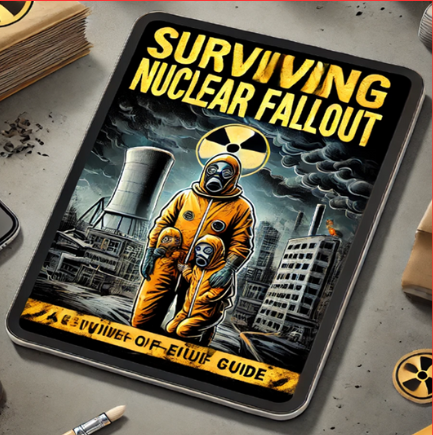
In today’s world, the threat of nuclear disasters looms larger than ever before. While we hope such catastrophic events never occur, it’s crucial to be prepared for the unthinkable. This comprehensive guide, “Surviving a Nuclear Fallout and After,” is designed to equip you with the knowledge and strategies necessary to navigate the aftermath of a nuclear disaster.
What is Surviving a Nuclear Fallout and After?
Surviving a Nuclear Fallout and After is a 39-page e-book that provides a comprehensive guide to surviving a nuclear disaster .
Emphasizing preparedness, immediate actions, and long-term strategies. By following these guidelines, you can enhance your ability to protect yourself and your family in the event of a nuclear disaster.
Understanding the risks and effects of nuclear fallout
Nuclear fallout is the radioactive debris that descends from the atmosphere after a nuclear explosion. It can contaminate the air, water, and soil, posing grave risks to human health and the environment. The effects of radiation exposure can range from mild symptoms to life-threatening conditions, including radiation sickness, cancer, and genetic mutations.
To mitigate these risks, it’s essential to understand the following:
- Types of radiation:
- Alpha particles
- Beta particles
- Gamma rays
- Radiation exposure pathways:
- External exposure (from radioactive materials outside the body)
- Internal exposure (from ingesting or inhaling radioactive materials)
- Factors influencing radiation exposure:
- Distance from the source
- Shielding
- Time spent in the affected area
By grasping these concepts, you’ll be better equipped to make informed decisions and take appropriate precautions during a nuclear fallout.
Steps to take before a nuclear disaster
Preparedness is key to surviving a nuclear disaster. Here are some essential steps to take before such an event occurs:
- Build an emergency supply kit: Stockpile non-perishable food, water, medication, and other essential supplies to last for at least two weeks.
- Create a family emergency plan: Establish a meeting place, communication protocols, and evacuation routes in case you’re separated during a disaster.
- Identify shelters: Locate the nearest fallout shelters or safe rooms in your area, and familiarize yourself with their locations and accessibility.
- Stay informed: Monitor official sources for updates and instructions from local authorities.
- Learn first aid: Acquire basic first aid skills, including how to treat radiation exposure and related injuries.
By taking these proactive measures, you’ll be better positioned to respond swiftly and effectively in the event of a nuclear emergency.
Immediate actions to take during a nuclear disaster
If a nuclear disaster strikes, time is of the essence. Every second counts, and your immediate actions can mean the difference between life and death. Here are some crucial steps to take:
- Take cover: If you’re outdoors, seek shelter immediately, preferably in a basement or a reinforced concrete structure. Avoid windows and exterior walls.
- Remove contaminated clothing: If you’ve been exposed to fallout, remove your outer layers of clothing and seal them in a plastic bag.
- Decontaminate: Wash your body and hair with soap and water to remove any radioactive particles.
- Stay tuned: Monitor emergency broadcasts and follow official instructions from authorities.
- Shelter in place: Remain in your shelter until instructed otherwise by officials, and conserve your emergency supplies.
By acting swiftly and following these guidelines, you can minimize your exposure to radiation and increase your chances of survival.
Creating a nuclear fallout emergency kit
A well-stocked emergency kit is a vital component of your nuclear fallout preparedness plan. Here’s what you should include:
- Water: At least one gallon per person per day for two weeks, plus additional water for pets.
- Non-perishable food: A two-week supply of canned goods, dried fruits, nuts, and other shelf-stable items.
- Medication: Prescription drugs, over-the-counter medications, and first aid supplies.
- Sanitation supplies: Toilet paper, garbage bags, disinfectants, and personal hygiene items.
- Radiation detection equipment: A Geiger counter or radiation dosimeter to monitor radiation levels.
- Protective gear: Respirators, goggles, gloves, and protective clothing.
- Communication devices: Battery-powered radio, extra batteries, and a hand-crank or solar-powered charger.
- Emergency tools: Duct tape, plastic sheeting, scissors, and other essential tools.
Remember to rotate and replenish your supplies regularly to ensure their effectiveness in an emergency.
Sheltering in place during a nuclear fallout
If a nuclear disaster occurs, sheltering in place may be your best option for avoiding exposure to radioactive fallout. Here are some guidelines for effective sheltering:
- Choose the right location: Basements or underground shelters offer the best protection. If those aren’t available, seek out the innermost room of your home or building, away from windows and exterior walls.
- Seal the shelter: Use plastic sheeting and duct tape to cover windows, vents, and doors, creating an airtight barrier against fallout particles.
- Limit ventilation: Minimize air circulation by turning off fans, air conditioners, and heating systems.
- Monitor radiation levels: Use a radiation detection device to track exposure levels and adjust your sheltering strategy accordingly.
- Conserve supplies: Ration your food, water, and other essentials to ensure they last as long as possible.
- Stay informed: Listen to emergency broadcasts for updates and instructions from authorities.
Sheltering in place can be physically and mentally taxing, but it’s a crucial step in minimizing your exposure to radiation and increasing your chances of survival.
Evacuation procedures and considerations
In some cases, evacuation may be necessary to escape the immediate danger zone of a nuclear fallout. If instructed to evacuate, follow these guidelines:
- Follow official instructions: Heed the instructions of local authorities regarding evacuation routes, destinations, and procedures.
- Pack essential supplies: Bring your emergency kit, including non-perishable food, water, medication, and protective gear.
- Minimize exposure: Limit your time outdoors and avoid areas with visible fallout particles.
- Seek shelter promptly: Once you reach your designated evacuation location, seek shelter and follow the guidelines for sheltering in place.
- Monitor radiation levels: Use a radiation detection device to track exposure levels and adjust your strategy accordingly.
Remember, evacuation can be a complex and potentially dangerous process. Always prioritize your safety and follow official instructions to the letter.
Dealing with contaminated food and water
In the aftermath of a nuclear disaster, access to safe food and water may be limited. Here’s how to handle contaminated supplies:
- Avoid exposed food and water: Discard any food or water that has been directly exposed to fallout particles or radiation.
- Decontaminate canned goods: Wash canned goods with soap and water to remove any radioactive particles before opening.
- Purify water: Boil water for at least one minute or use approved water purification methods to remove radioactive contaminants.
- Store safely: Store decontaminated food and water in airtight containers to prevent further contamination.
- Monitor radiation levels: Use a radiation detection device to check the safety of your food and water supplies.
Remember, ingesting contaminated food or water can lead to internal radiation exposure, which can have severe health consequences. Exercise caution and follow proper decontamination procedures.
Managing radiation exposure and its long-term effects
Radiation exposure can have lasting impacts on your health, even after the immediate danger has passed. Here are some strategies for managing radiation exposure and its long-term effects:
- Seek medical attention: If you suspect radiation exposure, seek medical attention immediately. Specialized treatments, such as potassium iodide and chelation therapy, may be necessary.
- Monitor your health: Be vigilant for symptoms of radiation sickness, such as nausea, fatigue, and skin burns. Seek medical advice if you experience any concerning symptoms.
- Practice self-care: Maintain a healthy lifestyle by eating a balanced diet, exercising regularly, and managing stress. These habits can boost your body’s ability to recover from radiation exposure.
- Undergo regular screenings: Consult with your healthcare provider about regular cancer screenings and genetic testing, as radiation exposure can increase the risk of certain cancers and genetic mutations.
By taking proactive measures to manage radiation exposure and its long-term effects, you can improve your chances of a full recovery and minimize the potential impact on your health.
Psychological and emotional well-being during a nuclear disaster
Surviving a nuclear disaster can be an emotionally traumatic experience. It’s essential to prioritize your psychological and emotional well-being during this challenging time. Here are some strategies to consider:
- Acknowledge your feelings: It’s normal to experience a range of emotions, including fear, anger, and anxiety. Allow yourself to process these feelings in a healthy manner.
- Practice stress management techniques: Engage in activities that promote relaxation, such as deep breathing exercises, meditation, or yoga.
- Seek support: Reach out to loved ones, support groups, or mental health professionals for emotional support and guidance.
- Maintain a routine: Establish a daily routine that includes regular mealtimes, exercise, and leisure activities to promote a sense of normalcy.
- Foster hope and resilience: Focus on the positive aspects of your situation and celebrate small victories. Remind yourself of your strength and ability to overcome adversity.
By prioritizing your psychological and emotional well-being, you’ll be better equipped to cope with the challenges of a nuclear disaster and maintain a positive outlook for the future.
Rebuilding and recovery after a nuclear disaster
Once the immediate danger has passed, the process of rebuilding and recovery can begin. Here are some considerations for this phase:
- Assess the damage: Evaluate the extent of the damage to your home, community, and infrastructure. Prioritize essential repairs and seek assistance from local authorities or relief organizations.
- Decontaminate your environment: Follow official guidelines for safely decontaminating your home, property, and belongings. This may involve professional remediation services.
- Rebuild with resilience: Incorporate disaster-resistant design principles and materials when rebuilding homes and infrastructure to enhance preparedness for future emergencies.
- Support community efforts: Participate in community-led initiatives for rebuilding and recovery, such as volunteer programs, fundraising efforts, and advocacy campaigns.
- Seek mental health support: Engage with mental health professionals to address the psychological and emotional impacts of the disaster, both for yourself and your community.
Rebuilding and recovery can be a long and arduous process, but by working together and prioritizing resilience, communities can emerge stronger and better prepared for future challenges.
Conclusion: Taking responsibility for your safety in a nuclear fallout situation
The threat of a nuclear disaster is a sobering reality, but by being proactive and taking responsibility for your own safety, you can significantly increase your chances of survival. “Surviving a Nuclear Fallout and After” provides a comprehensive guide to navigating the challenges of a nuclear fallout, from immediate actions to long-term recovery strategies.**Surviving Nuclear Fallout and After is a comprehensive guide to surviving nuclear fallout, emphasizing preparedness, immediate actions, and long-term strategies. By following the guidelines outlined in this e-book, you can enhance your ability to protect yourself and your loved ones in the event of a nuclear disaster. Don’t wait until it’s too late – take action today and invest in your safety and peace of mind.**





